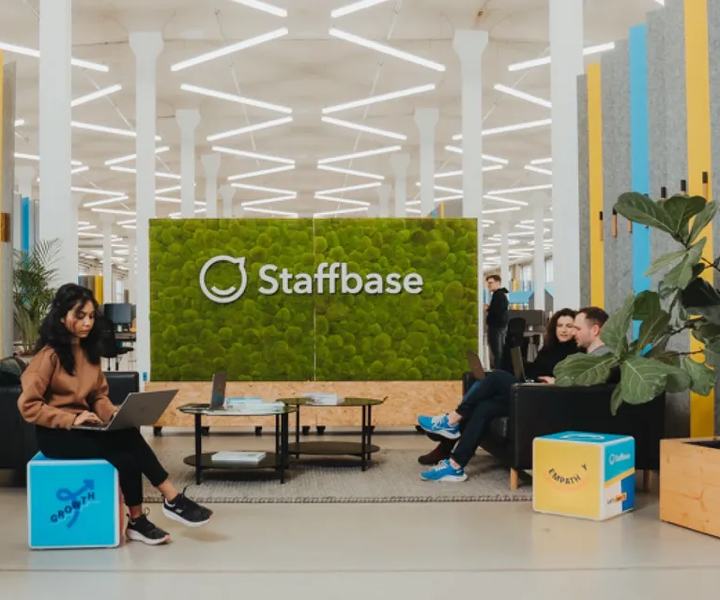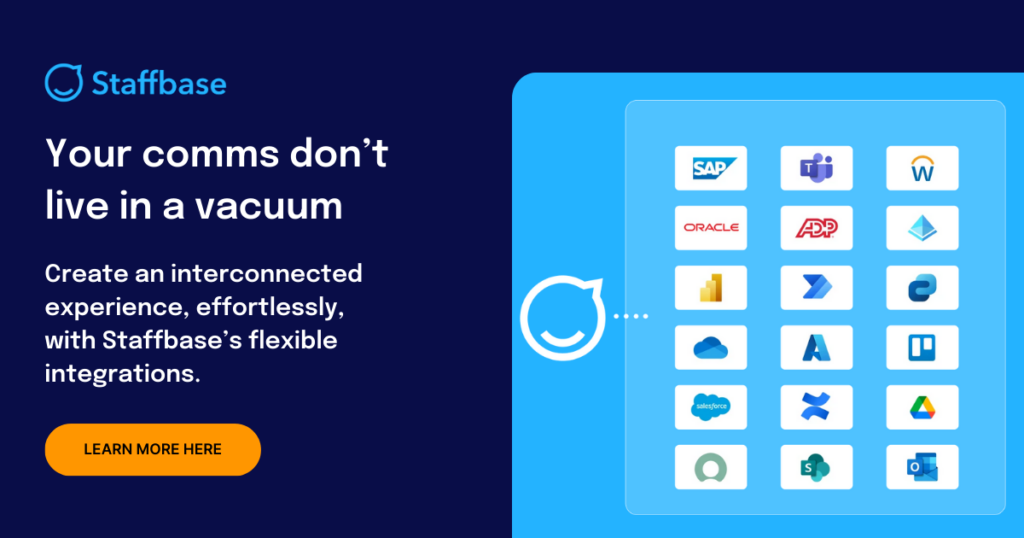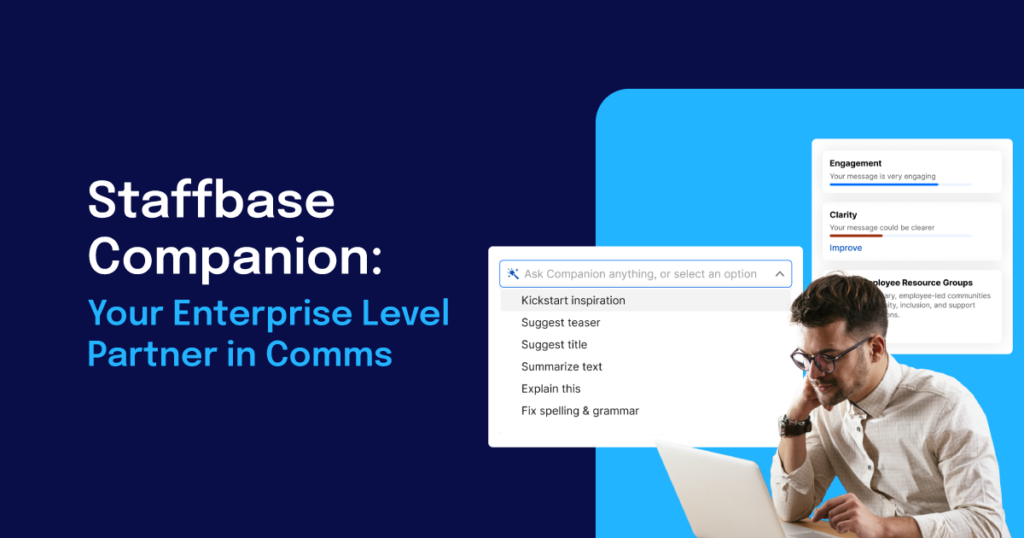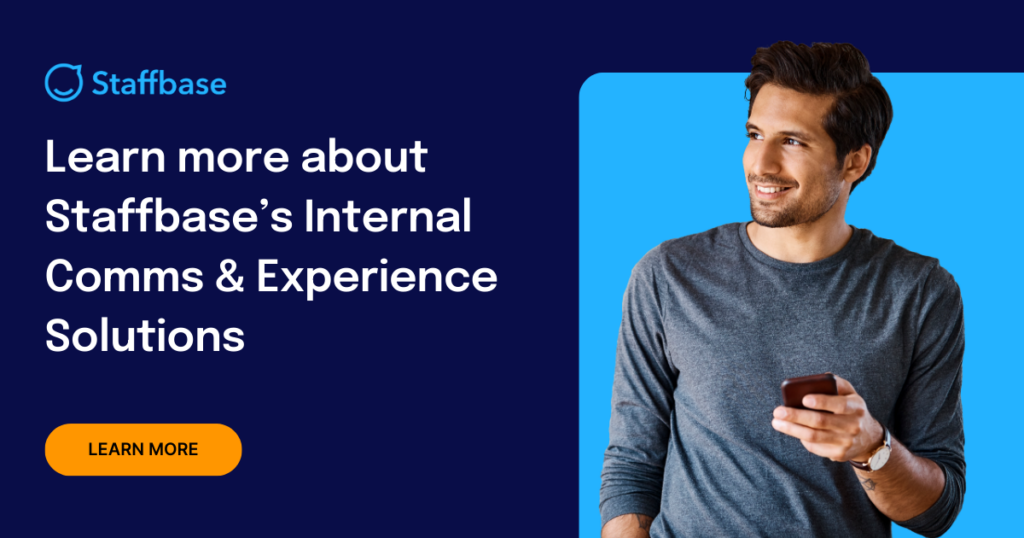Which Employee Experience Software is Best for Your Business? Our Top 10 Solutions

Creating a positive and fulfilling work environment is a must if you want to drive productivity and retention. And deploying the right tools and software platforms can supercharge the impact of your efforts. In this article, we’ll share ten of the most popular employee experience platforms on the market today to help you choose the right one for your organization.
What is employee experience software?
Employee experience software is a broad term for the various tools, apps, and platforms that organizations use to give their employees the best possible experience at work. It encompasses tools for strategic, top-down communications, employee feedback, and employee recognition and rewards.
These tools often integrate smoothly with other apps and platforms, providing a smooth and easy HR and comms experience for employees. And the best tools allow HR and communications teams to measure and analyze how team members are feeling in real time so they can iterate and improve the employee experience.
Essential features to look for in an employee experience platform
There are many different types of employee experience tools, which all come with unique functionalities. That said, the best platforms do have some features in common — here are some key things to look out for.
Advanced analytics
The best employee experience management software comes with reporting and analytics features that provide insights into employee sentiment and engagement. This allows admins to identify trends and nip problems in the bud before they get out of hand. Ultimately, these tools provide employers with the data they need to make stronger decisions and improve the employee experience over time.
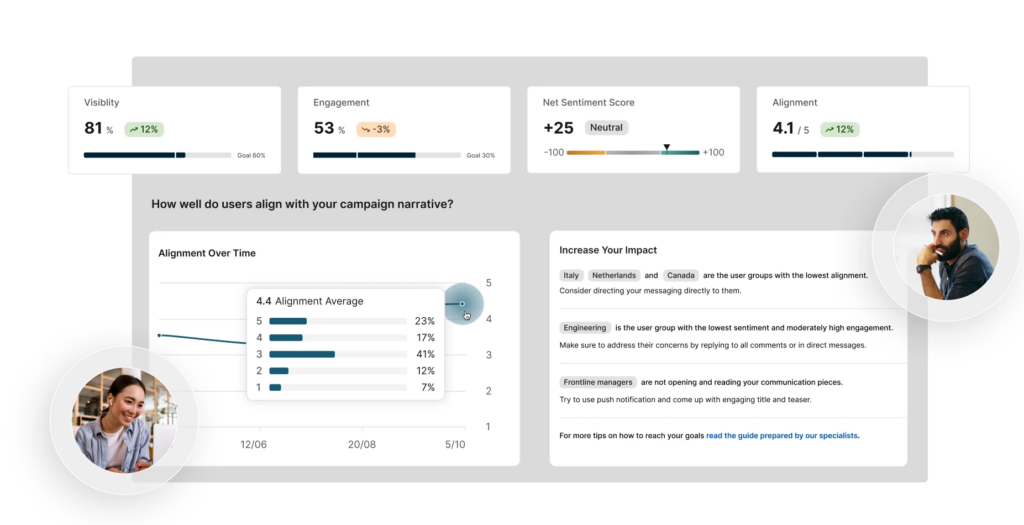
Integration capabilities
Most companies rely on a whole suite of tools and software to keep their operations running smoothly. And it’s important to ensure that any employee experience platform you implement can integrate seamlessly with the rest of your tech stack. The best employee experience platforms come with out-of-the-box integrations with key tools, and the ability to build your own through custom APIs.
Mobile accessibility
Frontline teams are often at a disadvantage when it comes to accessing employee experience tools, simply because they don’t work at computers. However, the best tools are available to the whole organization thanks to mobile apps that deskless workers can download on their work or personal devices.
User-friendly interface
The best employee experience tools are built around intuitive, user-friendly interfaces that are pleasant and engaging to use. That means these apps are easy for all users to understand and navigate, whether they’re accessing them through a mobile or desktop app.
AI capability
Some modern employee experience tools come with built-in AI capabilities, which allow users to automate repetitive tasks and provide even greater value for employees. For example, Staffbase’s AI Companion can curate tailored content and recommend articles, videos, and resources based on each employee’s needs.
Key benefits of employee experience software for today’s businesses
Before investing in any software solution, you need to know it will deliver results for your business. Here are some of the biggest benefits that employee experience software could bring to your organization:
Enhanced employee engagement: Employee experience platforms facilitate communication and collaboration between employees and management, which can help keep employees engaged, motivated, and satisfied.
Opportunities for employee recognition: Many employee experience platforms include functions for peer-to-peer and manager-led recognition and rewards, which helps employees feel valued at work.
Streamlined HR experience: The best employee experience software simplifies and automates key HR processes, resulting in a smoother experience for both admins and employees.
Stronger company culture: Employee experience management software promotes meaningful connections between employees and the company, helping to reinforce the company culture over time. Some platforms also tie employee recognition explicitly to company values, encouraging employees to work towards the organization’s core mission.
Reduced staff turnover: Naturally, employees who are more engaged and satisfied are likely to stick around for longer. That means employee experience software can have a big impact on your employee retention rate.
Top 10 employee experience platforms to consider
Wondering where to start? Here are ten of the top employee experience platforms you might want to consider implementing at your organization. For each one, we’ll share its key features, pros and cons, and pricing information.
1. Staffbase
Staffbase is a leading platform designed to enhance the employee experience from start to finish. It comes with a suite of tools including an employee intranet, employee app, email and SMS notifications, and digital signage — meaning it can be used to engage and empower onsite and frontline team members alike.
Staffbase supports top-down, bottom-up, and peer-to-peer engagement, with features like communities, social walls, surveys, and feedback forms designed to cultivate a sense of belonging and reinforce the company culture.
Plus, Staffbase’s strong admin features like advanced intranet analytics dashboards and a central control center allow internal communications and HR teams to measure engagement and assess where their efforts are having the greatest impact. Ultimately, this allows employees to continue adjusting their strategy to improve the employee experience over time.
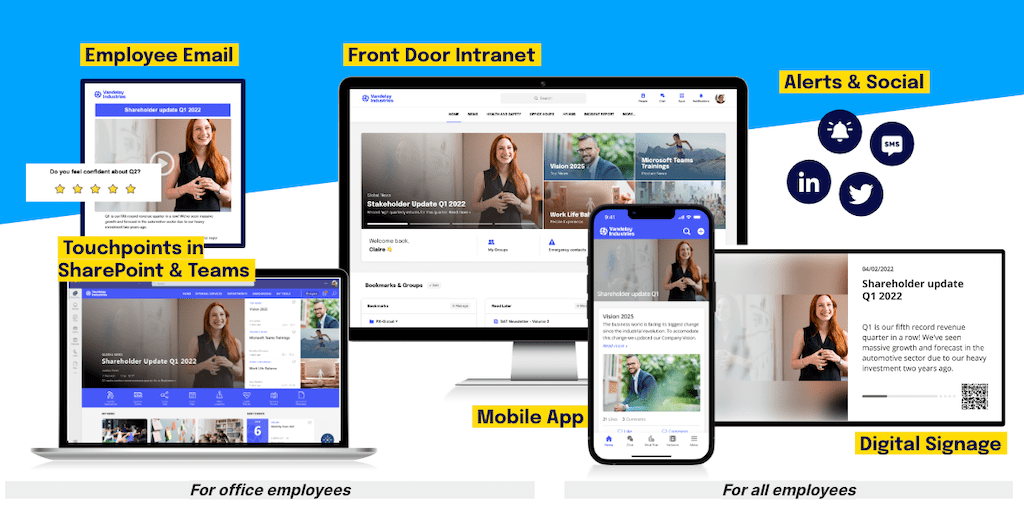
Key features
Numerous features for employee engagement and connection, including communities, newsletters, push notifications, employee spotlights, surveys, feedback forms, and social feeds
Tailored content paths to deliver crucial comms at key moments of the employee journey
Advanced analytics dashboards, providing admins with actionable insights
Fully branded mobile app available through public app stores
Smooth integrations with key HRIS systems and productivity suites including Microsoft 365
AI Companion to save time for both admins and users
Pros and cons
Enables businesses to effectively connect with all employees, whether in the office, working remotely, or on the frontline
Advanced features for strategic communications, ensuring employees are never left in the dark about key company updates
All-in-one solution for peer-to-peer social interactions, employee feedback, strategic communications, and more, providing a holistic experience for employees
No end-to-end human capital processes like payroll or expense reporting
Built for corporate communications, peer-to-peer engagement, and knowledge management, not best used solely as a social tool
Pricing
Staffbase has three main pricing plans, tailored to different business sizes and needs:
SMB: For companies with up to 100 employees; includes a branded mobile app, email and push notifications, news feeds, and more
Business: Includes all SMB features plus AI Companion, auto-translation, advanced analytics, editorial calendar, customization options, and APIs
Enterprise: Includes all Business plan features plus campaigns, ghostwriting, automated journeys, local content management (Spaces), and custom app distribution options
2. Qualtrics XM
Qualtrics XM is an experience management software designed to uncover insights and empower organizations to improve customer experience. The company’s employee experience offering applies the same principle to employees, effectively treating them as customers to ensure an exceptional experience. The platform includes internal marketing features like employee engagement surveys, trend monitoring, and point-in-time, solicited feedback through real-time, multi-channel passive listening.
Key features
Omnichannel ticketing system for admins to effectively manage employee requests and queries
Flexible survey options with a library of stored question types and built-in benchmarks
AI-powered predictive analytics, empowering managers to make informed decisions
Integrations with key workplace tools including Jira, Salesforce, and Slack
Pros and cons
Real-time feedback and insights on office-based and frontline employees
Combination of human and artificial intelligence to drive strategic, data-driven decisions
Limited customization options for surveys
Complex interface with a steep learning curve, which can negatively impact user experience
Pricing
Qualtrics Employee XM comprises three core modules: People Engage, People Lifecycle, and PeopleAnalytics. These can be purchased separately or combined. Qualtrics does not advertise specific pricing.
3. Motivosity
Motivosity is an employee recognition and rewards platform built around a simple concept: team members can reward each other with points when they do great work, and those points can then be converted into various prizes. The platform also includes personalized profiles for each employee and an organizational chart to help employees understand how everyone fits together.
Key features
Personalized profiles and personality tests that help employees connect and get to know each other
Wide range of rewards including gift vouchers, charitable donations, and pre-charged visa cards
Automated gift-giving for birthdays, work anniversaries, and other key milestones
Mobile app with Slack and Microsoft Teams connectivity, ensuring all employees are included
Pros and cons
Specifically ties recognition to company values, helping to reinforce them over time
Allows employees to choose prizes that are most valuable to them, improving motivation
Lengthy implementation process
Risk of overuse or misuse such as employees artificially rewarding their friends
Pricing
Motivosity offers three pricing tiers: Standard, Pro, and Custom. All plans have a $3,000 minimum annual spend. Exact prices are not advertised.
4. 15Five
15Five is a performance management and employee feedback platform that helps organizations to improve the employee experience. HR teams and management can use the tool to take a pulse of their teams’ views through simple surveys, and then use the AI assistant to synthesize data into actionable insights. 15Five also includes various features to help employees advance toward their career goals, such as one-on-one performance reviews, objectives, and progress tracking.
Key features
Easy-to-use surveys, accessible from any device
Performance management features supporting employee growth
AI assistant for insights on engagement, performance, retention, and manager effectiveness
Digital high-five feature to enhance employee recognition and value
Pros and cons
Provides a clear view of how employees are experiencing the workplace
Empowers employees to grow and develop
Strictly focused on performance management and employee feedback, with no features for other HR processes
Frequent emails and notifications can be distracting or annoying for employees
Pricing
15Five offers three pricing tiers:
Engage: $4 per user per month
Perform: $10 per user per month
Total platform: $16 per user per month
On-demand manager training and coaching packages are also available starting at $99 per month.
5. Blink
Blink is a mobile-first digital employee experience platform designed to connect and engage distributed and frontline teams. Admins can use the tool to gauge employees’ feelings on a topic through pre-built or custom surveys. Features like peer-to-peer kudos enable employee recognition, and a shared news feed gives employees access to crucial top-down communications. Essential resources can be found in the employee hub.
Key features
Hub for essential employee documents, including paystubs, policies, procedures, and other resources
News feed for real-time communications including news, social posts, and polls
Insights and analytics on employee satisfaction, engagement, and retention, helping HR and comms optimize the employee experience
Secure chat function for individual and group conversations, with dedicated channels for projects or teams
Pros and cons
Combines a social media-style news feed with an online knowledge base, giving employees everything they need in one place
Intuitive and easy-to-use interface, encouraging adoption and engagement
Basic analytics compared to other tools, with no AI analysis
No editorial calendar or collaboration tools for internal communicators
Pricing
Blink offers two pricing tiers, Business and Enterprise. Exact pricing is not advertised.
6. WorkTango
WorkTango is an employee experience platform focused on two main concepts: recognition and rewards, and surveys and feedback. The survey features allow admins to gather employee input and analyze it using the software’s built-in analytics function. Employees can also use the platform to give shout-outs to their peers and receive more formal recognition from managers. Rewards are tied to points which can be spent on millions of different prizes through the reward marketplace.
Key features
Anonymous conversations between managers and employees
Reward marketplace for employees to convert recognition into prizes
Automatic service awards and milestones celebrating key moments in the employee journey
Manager-led incentives that encourage team members to work toward specific goals
Pros and cons
Encourages a culture of support and recognition through peer-to-peer feedback
Wide range of prize options, helping increase employee motivation
Point expiration system creates unnecessary pressure for employees to cash in points
Learning period required for new employees, with some navigation challenges
Pricing
WorkTango includes two modules, which can be purchased separately or combined:
Recognition and rewards
Employee survey and insights
7. Zendesk
Zendesk is a customer service platform that has adapted its tools to enhance the digital employee experience. By essentially treating employees as customers, Zendesk enables HR, IT, and other key parties to provide fast solutions to issues through features like custom workflows, omnichannel ticketing, and a customizable dashboard.
Key features
Customizable help center for employees to access information and request assistance
Centralized workspace for HR and other admins to view and handle employee requests from any channel
AI assistance for triaging requests and automating workflows
Advanced analytics and reporting, transforming employee requests into insights
Pros and cons
Key integrations with apps like Slack and Teams, allowing users to meet employees where they are
Greater level of HR support with fewer resources thanks to AI and custom workflows
User interface can have a steep learning curve for some employees
Treats team members as customers; potentially off-putting for some
Pricing
Zendesk offers three pricing levels for its employee experience offering:
Support Team: $19 per agent per month
Support Professional: $55 per agent per month
Support Enterprise: $115 per agent per month
Additional custom plans are available for enterprises.
8. Workday Peakon Employee Voice
Workday is a powerful tool for streamlining HR processes, combining core functions like payroll, employee onboarding, and performance management in one platform. Its employee experience offering, Peakon, helps employers monitor employee sentiment through intelligent listening technology. Instead of surveys, the platform is built around anonymous, one-on-one conversations between employees and leadership or HR. Admins can then use the built-in AI to uncover trends and insights.
Key features
Confidential two-way conversations between employees and managers
Personalized dashboards for users and admins
Analytics and reporting powered by AI
Targeted action plans and contextual learning and development resources
Pros and cons
Accessible to onsite, remote, and frontline employees through email, SMS, Teams, Slack, or kiosks
Allows employers to take a proactive approach to employee listening and identify trends and patterns
Rating scales can be confusing for some users
May not be appropriate for small teams where anonymity can be compromised
Pricing
Packages start at $2000 per year.
9. Kudos
Kudos is an employee experience management platform built around recognition and rewards. As the name suggests, it allows both managers and peers to give shout-outs to team members who do great work. These are specifically tied to company values. Employees can use their points to “buy” prizes including gift cards, electronics, and even non-monetary rewards like lunch with the company CEO.
Key features
Employee sentiment pulse surveys to measure and track engagement
Automated celebrations for milestones like work anniversaries and birthdays
Analytics dashboards where admins can measure performance, understand team dynamics, and uncover other key insights
Key integrations with Slack, Outlook, Teams, and more
Pros and cons
Encourages team members to celebrate each other, strengthening company culture
Uses monetary and other rewards to increase motivation and enhance engagement
Unused Kudos don’t roll over into the next month, meaning unspent points are lost
Can be difficult for some users to navigate
Pricing
Pricing starts at $3.25 per user per month.
10. Workleap Officevibe
Workleap is an all-in-one HR solution that combines features like performance management, onboarding, and more under one umbrella. The company’s employee experience offering, Officevibe, allows HR and leadership to measure engagement through tools like pulse and customized surveys, eNPS scoring, and one-on-one meetings between managers and team members. The platform also includes recognition features where both colleagues and managers can give kudos for a job well done.
Key features
Automated pulse surveys to collect real-time feedback and understand employee sentiment
Peer-to-peer shout-outs with comments and emoji reactions
Analytics and reporting to reveal the most appreciated employees and top appraisers
Performance tracking tools including one-on-one meetings, OKRs, and goal-setting
Pros and cons
Affordable compared to other solutions on the market
Fast access to insights on employee sentiment and engagement
User interface can be confusing to navigate
Reporting may be too limited for large enterprises
Pricing
Officevibe has a free plan with limited features and two paid tiers:
Essential: $3.50 per user per month
Pro: $5 per user per month
Add-ons are available for an additional cost, and customers can save when bundling Officevibe with other Workleap products.
Key considerations when choosing an employee experience platform
These days, there are so many employee experience platforms on the market that it can be difficult to know where to start when choosing a solution. Here are a few factors to keep in mind when making your decision:
Features: Naturally, you need to make sure that the solution you choose will meet your company’s needs. And, since all employee experience platforms are different, that means taking a deep dive into the features each one can offer. Look for solutions that offer a free demo so you can see the software’s main features in action.
User-friendliness: An employee experience platform will only work if your employees actually use it. But they’re busy people — and they probably don’t have time to learn the ins and outs of a whole new complex program. Look for software solutions that prioritize user-friendly experiences and have a track record for high adoption and engagement. Again, signing up for a free demo can give you a good idea of a platform’s usability in practice.
Integration options: Your employees probably already use a lot of different tools, apps, and platforms to do their jobs. That means if you want to boost adoption of your employee experience software, you need to make sure it will slot neatly into your existing tech stack. Look for solutions that integrate with the HR tools, productivity suites, and communication platforms your teams already use.
Scalability: When looking for any sort of software solution, you need to think about the future. After all, your organization will probably not look the same in five years (or ten, or twenty) as it does today. The best employee experience platforms will grow with your organization, allowing you to change your plan or add new modules as your needs evolve.
Customer support: Every piece of software goes wrong at least once in a while — and you need to be sure you’ll be able to access the support you need if that happens. Before committing to a software provider, you should ask about the level of customer support they provide and read testimonials to get an idea of how quickly and effectively they’ll resolve any issues.
Pricing: Lastly, you’ll need to ensure that any software you choose fits into your budget. Employee experience tools come at a wide range of price points, with some even offering free trials or freemium versions. However, keep in mind that it’s not just about how much you pay, but how much value a platform delivers. That means the cheapest solution may not necessarily be the best one for your organization.
The importance of internal communications for enhancing the employee experience
Internal communications play a crucial role in building a positive employee experience. By delivering the right strategic comms at the right time, internal comms professionals can help employees feel part of the company culture. And with the right tools, you can ensure those employees feel engaged and connected whether they’re in the office, working remotely, or out in the field.
No matter which employee experience software you choose, you need to make sure it’s backed up by a solid plan for top-down, bottom-up, and peer-to-peer communication. After all, the employee experience is fundamentally about real, human interactions. The best employee experience software should seek to facilitate and optimize those interactions — not replace them.





